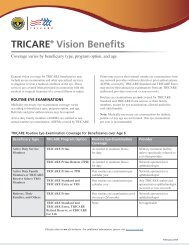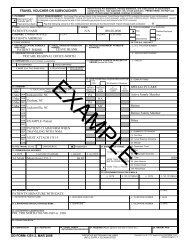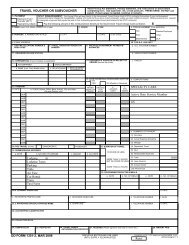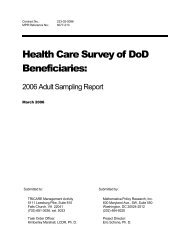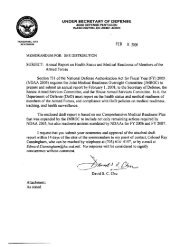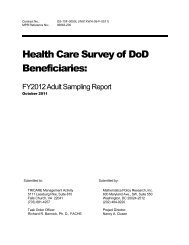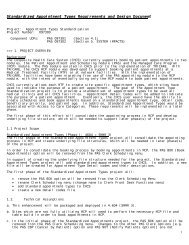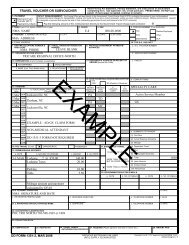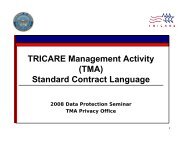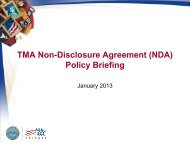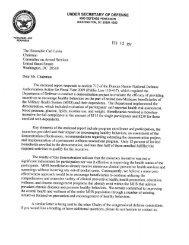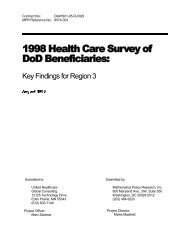Medical Management Guide, 2009, Version 3.0 - Tricare
Medical Management Guide, 2009, Version 3.0 - Tricare
Medical Management Guide, 2009, Version 3.0 - Tricare
- No tags were found...
You also want an ePaper? Increase the reach of your titles
YUMPU automatically turns print PDFs into web optimized ePapers that Google loves.
Page 32Utilization <strong>Management</strong> <strong>Version</strong> <strong>3.0</strong><strong>Medical</strong> <strong>Management</strong> <strong>Guide</strong>UM staff can also apply review criteria to assist theMTF in identifying areas for improvement within thesystem. For example:• If a group of admissions are reviewedretrospectively using McKesson ® InterQual ®evidence-based decision support criteria and alarge number do not meet admission criteria,further investigation is warranted to determineand resolve the underlying cause.• If a group of cases referred for specialty caredoes not meet Milliman Care <strong>Guide</strong>lines ® , atraining issue may exist indicating the need foradditional clinical education.In both instances cited above, the criteria orguidelines have been used to reveal potential areasfor improvement, but the admissions and referralswere not denied. (For more information, seeOutcome Measurement and <strong>Management</strong>, laterin this section.)Types of ReviewThe procedures for UR may be:• Prospective (before care is provided—preadmission)• Concurrent (while care is in process— hospitalization)• Retrospective (after care has been provided— discharge)Prospective review is designed to evaluate proposedtreatment, determine medical necessity, and assessthe appropriate level of care prior to the deliveryof services. When performing reviews, referralsto CM or DM target early intervention to improveoutcomes. Formal prospective review determinationsrequire timely attention. Prospective reviews are onlyvalid for 30 days. If treatment was authorized butnot initiated within the window, the review shouldbe repeated.The MTF’s plan for UR may include more focusedreviews in which it identifies a list of healthcareservices for which preauthorization and concurrentreview may be required. It is neither necessary norcost effective to perform a 100 percent review of allreferrals for medical necessity. Criteria for UR mayinclude, but are not limited to, services defined byany of the following characteristics:• Costly• Known to pose potential medical risks formembers• Known to produce variable outcomes• New or investigational• Often performed for cosmetic reasons• Overutilized• Utilized differently by various providersConcurrent review is designed to evaluate carewhile it is occurring to validate medical necessity,appropriateness, and quality of care. The revieweralso looks for delays in service or complications,assesses if tests are appropriate, or evaluates thestatus of discharge planning.Inpatient concurrent review consists of twocomponents:• Admission review is conducted within 24 hoursof admission or on the next business day toverify the appropriateness and medical necessityof the hospitalization. Documentation in themedical record should justify the admission andplan of care. Discharge planning must begin atthe time of admission to resolve potential issuesthat may delay timely discharge or prevent thebest patient outcome.



